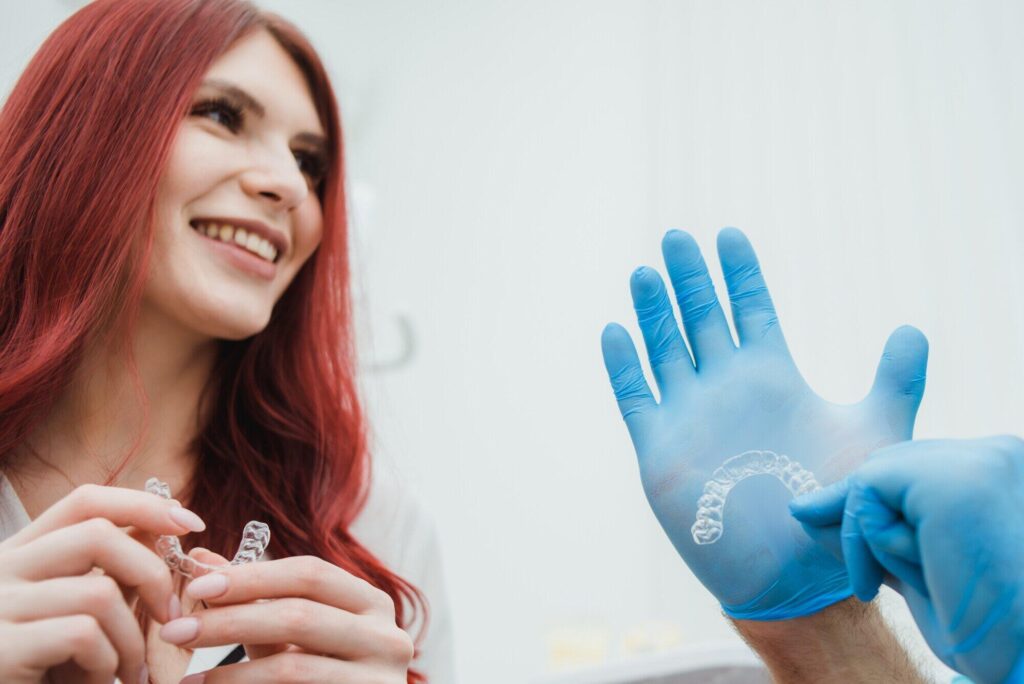In the world of health and beauty, smiles matter more than ever. A bright, even smile can boost your confidence, improve your social life, and even help with job opportunities.
But getting that perfect smile isn’t always easy. That’s where modern dental makeovers come in-and thanks to new technology, they’re better, faster, and more comfortable than ever.
This article takes a close look at how technology is changing the way dentists help people improve their smiles. From digital scans to 3D printing, lasers to clear aligners, let’s explore the many ways technology plays a big role in today’s dental makeovers.
What Is a Dental Makeover?
A dental makeover, sometimes called a “smile makeover,” includes different treatments that improve how your teeth look and work. These treatments can include:
- Teeth whitening
- Braces or clear aligners
- Veneers
- Dental implants
- Crowns or bridges
- Gum reshaping
Some people want a better smile for cosmetic reasons. Others need dental work for health or function. Often, it’s a mix of both. Either way, modern technology helps make these changes smoother, quicker, and more precise.
Digital Scans: Goodbye, Messy Molds
In the past, getting impressions of your teeth meant biting into gooey material that hardened in your mouth. It was messy and uncomfortable.
Now, most dentists use digital scanners. These are small cameras that quickly take thousands of pictures of your teeth and gums.
With these digital scans, your dentist gets a complete 3D model of your mouth in just a few minutes. It’s faster, cleaner, and far more accurate. Better scans mean better-fitting crowns, aligners, and veneers.
Designing Smiles on a Computer
With a 3D scan, your dentist can use special software to design your perfect smile. This is called Digital Smile Design (DSD).
The software allows the dentist to:
- Adjust tooth shape and size
- Try different shades of white
- Align teeth digitally
- Match your smile and face
Even better, you get to see a preview of your new smile before any work begins. You can give feedback and make changes until it looks just right. That makes the process less stressful and more exciting.
CAD/CAM: Making Crowns and Veneers Faster
CAD/CAM stands for Computer-Aided Design and Computer-Aided Manufacturing. With this technology, dentists can design and build things like crowns, veneers, or bridges right in the office.
Here’s how it works:
Your mouth is scanned digitally. The dentist designs the crown or veneer on a computer. A machine mills the new tooth from a block of ceramic. It’s polished, colored, and placed-all in one visit.
No need to wear a temporary crown for weeks while you wait for a lab. CAD/CAM makes dental work faster, more accurate, and more convenient.
3D Printing in the Dental Office
3D printing is another tool changing dentistry. It’s used to make:
- Clear aligners
- Temporary crowns
- Dental models
- Surgical guides
- Custom trays
- Dentures
With a 3D printer, dental tools and appliances can be made quickly and at a lower cost. This helps patients get treatments sooner and often for less money. The ability to test and adjust printed models also means better results.
Laser Dentistry: Gentle and Precise
Many dentists now use lasers for common procedures. Lasers are quiet, accurate, and cause less pain than traditional tools.
They’re used for:
- Gum reshaping
- Teeth whitening
- Removing decay
- Soft tissue surgery
Laser treatments usually cause less bleeding and heal faster. That means a more comfortable dental experience.
Clear Aligners: Braces You Can’t See
Traditional metal braces work well, but many people avoid them because they’re noticeable and hard to clean. Today, clear aligners like Invisalign offer a better option for many.
Clear aligners are custom trays made to move your teeth slowly over time. Every few weeks, you switch to a new set. These aligners are:
They are nearly invisible. It’s removable for eating and brushing. It’s more comfortable than metal braces.
Dentists use 3D scans and computer models to plan your treatment. Some even use apps that let you check in from home. No more monthly visits if things are going well.
Artificial Intelligence (AI): Smarter Planning
AI is playing a growing role in dental care. It can read X-rays to find cavities or gum disease. It can also help dentists choose the best treatment options.
Additionally, it can predict how your teeth will move with aligners. Lastly, it can simulate how your smile will look after treatment.
With AI, diagnosis and planning become faster and more accurate. It also helps catch problems early, before they become more serious.
Personalized Treatment Plans for Every Smile
No two smiles are the same, and now, thanks to technology, dental treatments no longer have to be one-size-fits-all. With digital tools, dentists can create personalized treatment plans that match each patient’s needs, goals, and facial structure.
Here’s how personalization works:
- Digital smile simulations
- Custom aligners
- AI recommendations
- 3D imaging
This means better results, more comfort, and higher satisfaction-because your smile makeover is designed just for you. Consulting the best dentist can help in your journey to improving your smile.
Virtual Consultations: Starting Your Smile Journey from Home
Before even stepping into a dental office, many patients can begin their makeover journey with a virtual consultation. These digital appointments let patients meet their dentist, ask questions, and share goals-all from home.
Benefits of virtual consultations:
- Easy scheduling and flexible timing
- Less pressure and more relaxed conversation
- Ability to upload photos or dental records ahead of time
- Clear understanding of treatment options and costs
This makes it easier for people to take the first step toward a better smile-especially those who may feel anxious or busy.
Eco-Friendly Innovations in Dentistry
As technology improves dental care, it’s also opening the door to greener, more sustainable practices. Many dental offices are adopting eco-friendly tools and workflows to reduce their impact on the environment.
Some examples include:
- Digital impressions
- 3D printing
- LED curing lights
- Paperless records
As patients become more eco-conscious, green dental technology is helping clinics meet those expectations while still delivering top-quality care.
Teledentistry: Care Without the Chair
Teledentistry means getting dental care online or through an app. While you still need to visit the dentist for some procedures, many things can now be done remotely:
- First-time consultations
- Reviewing treatment plans
- Checking in during clear aligner treatment
- Asking questions about healing or pain
This is great for people who live far from a dentist or have busy schedules. It also became very popular during the COVID-19 pandemic and is likely here to stay.
VR and AR: High-Tech Help for Dentists and Patients
Virtual Reality (VR) and Augmented Reality (AR) are still new in dentistry, but they’re starting to make an impact. VR can calm patients by showing peaceful images during a procedure. AR can help dentists see a 3D overlay of your anatomy during surgery.
Both can be used to train new dentists with realistic practice sessions. These tools aren’t yet common in all clinics, but as they improve, they could become a regular part of dental care.
Combining Art and Science in Smile Design
While technology helps with accuracy, a beautiful smile makeover still requires an artistic eye. Dentists use design software not just for technical planning, but also to shape smiles that match a person’s personality and facial features.
This blend of science and creativity includes:
- Matching tooth shapes to face shape and lip curve
- Choosing color shades that suit skin tone
- Designing symmetry that looks natural, not artificial
- Paying attention to the emotion behind a smile
It’s not just about fixing teeth-it’s about designing a smile that feels uniquely yours. And that’s where art meets precision.
New Materials for Better Results
Technology isn’t just about machines-it also includes better materials. New dental materials are:
- Stronger
- More natural-looking
- Longer-lasting
- Safer and more biocompatible
Some even help your body heal faster. For example, bioactive materials can encourage bone growth around dental implants. Nanomaterials make fillings more durable and stain-resistant. These advances help your dental work look better and last longer.
Technology Reduces Dental Anxiety
For many people, visiting the dentist can be stressful. The sound of drills, the fear of pain, and the memory of bad past experiences can make patients avoid important dental care. Thankfully, technology is making dentistry much more comfortable-and even relaxing-for nervous patients.
Here’s how:
- Quieter tools
- Shorter procedures
- Better communication
- VR headsets
By reducing stress, more people feel comfortable getting the dental care they need, and even looking forward to improving their smiles.
Faster Recovery, Less Downtime
One of the biggest benefits of technology in dental makeovers is how it helps people bounce back more quickly after treatment. Older methods often involved pain, swelling, and long healing times. With today’s tools, recovery is often faster and easier.
For example:
Laser treatments cause less bleeding and swelling than traditional surgery. 3D-printed appliances fit better and require fewer adjustments. Digital planning helps avoid surprises and errors that could slow healing.
Minimally invasive techniques protect healthy tissue and speed up recovery. Whether it’s getting back to work, school, or social activities, patients appreciate that modern dental care doesn’t mean long downtime anymore.
The Human Touch Still Matters
Even with all these incredible technologies, one thing hasn’t changed: the importance of the dentist’s skill and experience. Technology helps make treatments faster and more precise, but it’s the dentist who plans, adjusts, and makes key decisions.
A good dental makeover still depends on:
- Careful listening to the patient’s goals
- Skilled hands to apply the tools and materials
- Artistic sense to create a natural-looking smile
- Judgment to know when and how to use each technology
Technology is a powerful partner, but it’s the human touch that brings everything together into a smile that truly fits the person.
Training Dentists for a High-Tech Future
With so many new tools in modern dentistry, training has become more important than ever. Dentists today must learn to combine traditional skills with cutting-edge technologies to provide the best results.
Dental schools and continuing education programs are now teaching:
How to use 3D scanners, printers, and CAD/CAM software. Best practices for laser and digital procedures.
Ethics and privacy in using AI and digital patient data. New materials and techniques for cosmetic and restorative work.
By staying up-to-date, dentists can offer safer, smarter, and more effective dental makeovers that reflect the latest in care and comfort.
Patient Empowerment Through Technology
One of the most powerful changes technology has brought to dental makeovers is how it empowers you, the patient. Instead of just receiving treatment, patients now play a more active role in designing their smiles.
Technology enables:
- Previewing results
- Tracking progress
- Comparing options
- Understanding procedures
This greater transparency helps patients make confident, informed decisions. It also builds trust and improves satisfaction, because people feel involved, not just treated.
The Cost and Ethics of High-Tech Dentistry
While all this technology is exciting, it also comes with challenges. High-tech dental work can be expensive. Not everyone has access to it, especially in rural areas or developing countries.
There’s also a risk of over-treatment. Because procedures are faster and easier, some clinics may suggest cosmetic work that isn’t really needed.
And since much of this technology uses personal data and images, privacy is another concern. Dentists need strong data protection policies to keep patients’ information safe.
What’s Next for Dental Makeovers?
The future of dental technology is full of promise. Here are a few things coming soon:
Smart dental materials that adjust to pressure or temperature. Genetic testing to personalize treatments.
Fully robotic procedures for implants or crowns. Even smarter AI that can design entire treatment plans in seconds.
These tools will make dental makeovers more precise, less painful, and more available to everyone. Dentists will still be essential, but they’ll be working side by side with advanced machines and software.
Technology Makes Smiles Better
In conclusion, the role of technology in modern dental makeovers is evident in its ability to provide patients with faster, more accurate, and aesthetically pleasing results. With advanced tools such as CAD/CAM technology and 3D imaging, dental makeovers have become more efficient and personalized.
Embrace the power of technology and schedule your dental makeover today! Don’t wait any longer to achieve the smile of your dreams.
If you want to read more articles, visit our blog.







